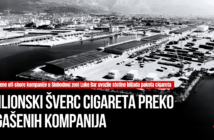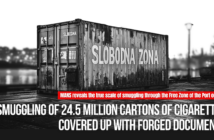Tender drawn for Milo’s partner
One year before it won the tender for construction and exploitation of small hydropower plants in Berane, the company that was one of the founders of “Hidroenergija Montenegro” had conceptual designs for the construction of small power plants on the rivers in Berane, MANS Investigative Centre reveals.
Berane-based company “Hidroenergija Montenegro”, which currently has six constructed small hydropower plants in the area of that municipality, was established in June 2007, only a few months before the Government of Montenegro launched the first tender for awarding concessions for the construction of small hydropower plants, which was published in November of that year.
The company was founded by Podgorica-based company “Hemera Capital”, owned by the controversial businessman Oleg Obradović, and company “Fortis” from Berane, represented by Ljubomir Obradović. The founding stake of “Hemera Capital” was €25 thousand or 70 %, while “Fortis” provided projects and other studies, worth €7.5 thousand euros or 30 % of the share.
Studies and conceptual designs related to the construction of several small HPPs in Berane (small HPP Bistrica, Konjsko, Krdzulje), and the documentation in possession of the MANS Investigative Center reveals that there was an agreement between “Fortis“ and Ljubljana-based “Hidroenergija“ on their construction, while back in November 2006, the Slovenian company submitted an invoice for reimbursement of these services.
It was 2006 that was the crucial year that paved the path for future work with small HPPs, because in that year the Government adopted several documents that were the basis for the first tender in the next year.
Investors were able to propose locations for small HPPs
When in May 2006 it adopted the Development Strategy on small HPPs, the Government indicated that the simplified method of awarding the concession should be provided.
“The free initiative of investors should be enabled in such way that it can initiate a request for granting a concession for small HPPs at an arbitrary location, as well as launch exploration and other works for implementation of the small HPP project,” the document states.
The strategy also reveals that the sites where new small HPPs will be built were not precisely defined, there were no long-term hydrological measurements on many watercourses, while environmental properties of the sites were also not explored, which made it impossible to define realistic technical solutions.
First, in March 2006, the Government established the Development Strategy of small HPPs, which designed a series of benefits for future investors, such as compulsory purchase of electricity, guaranteed incentive prices within a minimum period of 10 years (provided that it does not violate market principles) or tax and loan incentives.
The strategy did not mention the location where the future small HPPs in the country would be constructed, but it was a clear signal to domestic investors on what kind of benefits they could count on from the deal with hydropower plants.
Then, in November 2006, the Government, headed by the then Prime Minister Milo Đukanović, adopted a decree on allocation of concessions for the use of rivers for the production of electricity from the small HPPs and defined the complete tender procedure for their allocation according to it.
A year later, it announced the first tender for the award of concessions, and offered it for two rivers in Berane – Bistrica and Šekularska. “Hidroenergija Montenegro” won the tender for these two watersheds, and was granted the right to build as many as 13 small HPPs.
The fact that “Hidroenergija Montenegro” seriously counted on granting concessions for the construction of small HPPs on two rivers in Berane was backed by the decision of the Berane Municipal Assembly from the end of October 2007, i.e. a month before the announcement of the tender, by which it decided to enter into the ownership of that company in a percentage of 3.33%. However, the implementation of the decision never happened.
According to the latest official data, current majority owner of “Hidroenergija Montenegro”, which annually receives millions of Euros from the sale of electricity, is a businessman Ranko Radović with 60%, while “Hemera Capital” has the remaining 40% of the ownership.
Ines Mrdović
MANS Investigative Centre



